Part 2: Dances of Western Europe and its Colonies
6 Colonial Dances of Mexico, Central America, and the Caribbean
1. The Colonization of Central America and the Caribbean
Like the rest of the New World, the Caribbean, Mexico, and Central America were targets of the Imperial powers of Europe from the 15th century until modern times. As such we see significant European influences on the dance and music cultures of these regions. All of the largest colonial powers (especially Britain, Spain, and Portugal) had a profound impact on the music and dance of these regions, as did the cultures of the enslaved populations they kidnapped and brought with them from Africa.
We already discussed the impact of the British Empire on the United States and Canada in chapter 4, but they also were a significant power in the Caribbean – in particular in Jamaica, the Virgin Islands, Bahamas, Barbados, Antigua and Barbuda, the Cayman Islands, Saint Kitts and Nevis, Turks and Caicos, Saint Lucia, Grenada, Dominica, St. Vincent, and Trinidad and Tobago. They also had isolated colonies in Central and South America including Guyana and Belize.
Geographically speaking the Spanish Empire rivaled the British empire as one of the largest in history. It covered territories around the world. After the defeat of the Moors and the reconquest of the Iberian Peninsula, the expansion of the Spanish state arguably began with Christopher Columbus in 1492, whose voyage was funded by the Spanish crown in search of new sources of resources. In the 16th century, we see the start of the age of the conquistadors including Hernán Cortés and Francisco Pizarro, conquering and devastating arguably equally sophisticated indigenous civilizations such as the Aztec Empire in Mexico, the Maya in Central America, and the Inca Empire in South America. Spain established vast colonial territories in the Americas, known as New Spain, encompassing present-day Mexico, Central America, South America, and parts of the Caribbean. Colonization led to the exploitation of indigenous peoples, the extraction of natural resources, and the establishment of Spanish settlements. During the 18th century, we start to see a decline in the power of the Spanish Empire, but by that point the European cultural colonialization was irreversible. By the 19th century, there were massive independence movements in much of Latin America and we see rebellions against the Spanish throughout the region. Former Spanish colonies include parts of the United States (Modern California, Arizona, New Mexico, Texas and Florida), Mexico, Cuba, Puerto Rico, Dominican Republic, Argentina, Bolivia, Chile, Colombia, Costa Rica, Ecuador, El Salvador, Guatemala, Honduras, Nicaragua, Panama, Paraguay, Peru, Uruguay, and Venezuela.
France was also an imperial power with reach into the Americas. Former French colonies include Louisiana, Acadia and Quebec in North America, which were discussed in chapter 4. In the Caribbean, they had colonies in Haiti, Martinique, Saint Martin, Saint Barthélemy, Guadalupe and other islands of the French Antilles. The story of Haiti is particularly interesting. Located on the western part of the island of Hispaniola, the island was claimed by Spain after Christopher Columbus’s arrival in 1492, and later divided between Spain and France, which established the colony of Saint-Domingue, which later became Haiti. The indigenous inhabitants of Haiti, the Taino, disappeared either by programs of genocide or by assimilation into the African slave populations. Haiti became one of the wealthiest colonies in the Caribbean due to its sugar and coffee plantations, worked by enslaved Africans. Inspired by the French Revolution, a slave revolt led by Toussaint Louverture began in 1791, culminating in Haiti’s declaration of independence in 1804, making it the first post-colonial black republic and the first country in the western world to abolish slavery. Despite this historic achievement, Haiti has faced ongoing challenges, including political instability, economic difficulties, and natural disasters.
The island of Martinique was claimed by France in 1635. The island became a significant French colony, heavily involved in the sugar and rum industries, which relied on enslaved African labor until slavery was abolished in 1848. Despite its tumultuous history, including the devastating eruption of Mount Pelée in 1902 that destroyed the town of Saint-Pierre, Martinique remained under French control and is now an overseas department of France.
The Dutch established several key colonies in the Caribbean, beginning in the early 17th century under the Dutch West India Company. Notable colonies included Curaçao, Aruba, Bonaire, Sint Eustatius, Saba, and Sint Maarten. Sint Eustatius, known as the “Golden Rock,” was a pivotal trading hub in the 18th century. These islands were strategic for trade and military operations. Slavery was abolished in 1863, leading to significant social changes. Today, Aruba, Curaçao, and Sint Maarten are autonomous countries within the Kingdom of the Netherlands, while Bonaire, Saba, and Sint Eustatius are special municipalities, maintaining cultural and historical ties to their Dutch heritage.
2. The Caribbean
2.1. History and Geography
The Caribbean is a region consisting of numerous countries located in and around the Caribbean Sea near Central America. Here’s a list of the islands and territories that are generally considered part of the Caribbean: Antigua and Barbuda, Aruba, The Bahamas, Barbados, Cuba, Dominica, Dominican Republic, The Dutch Antilles, Grenada, Haiti, Jamaica, Saint Kitts and Nevis. Martinique, Saint Lucia, Saint Martin/Sint Maarten, Saint Vincent and the Grenadines, Trinidad and Tobago, Turks and Caicos, the British Virgin Islands, The US Virgin Islands, the Cayman Islands, and others.

The indigenous people of the region were almost entirely wiped out by colonization. While some people still identify as Taíno people – a sub-group of the Arawak found on many Caribbean islands – the group was largely killed off by disease and violence or was completely assimilated by European settlers and by their slaves. Other peoples speaking related Arawak languages are still found in small groups around the Caribbean coastline of South America. There are only a few thousand of the Kalinago people (formerly known as the Carib, who gave that name to the Caribbean) are left in Dominica. As indigenous populations declined, European colonizers increasingly turned to African slave labor to meet the labor demands of their colonies. Today the populations of Caribbean countries are typically either descendants of the Spanish or descendants of African Slaves.
2.2. Dress
Folk costumes throughout the Caribbean are noted for their bright colors, sparkles and large accessories. This is particularly true of costumes for Mardi Gras/Carnivale and other festivities. Often celebrants wear masks and highly elaborate decorations. But even more casual everyday dress is noted for being in bright and shiny materials. Less elaborate women’s folk costumes include the Kwadril (Quadrille) dress and the Gwan Wob in former French colonies. These costumes are based on the fashion of white colonizers in the 19th century. Men often wear loose white linen shirts (guayabera) and pants cut off at the calf, vests, bandanas and straw hats.
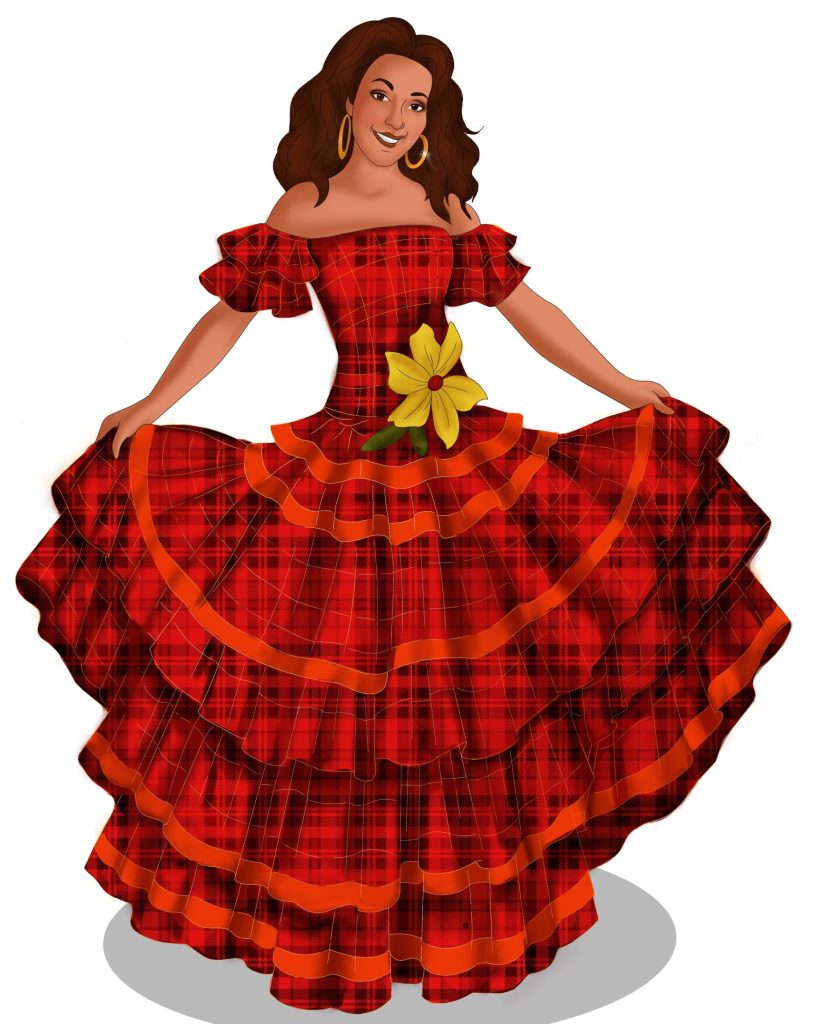
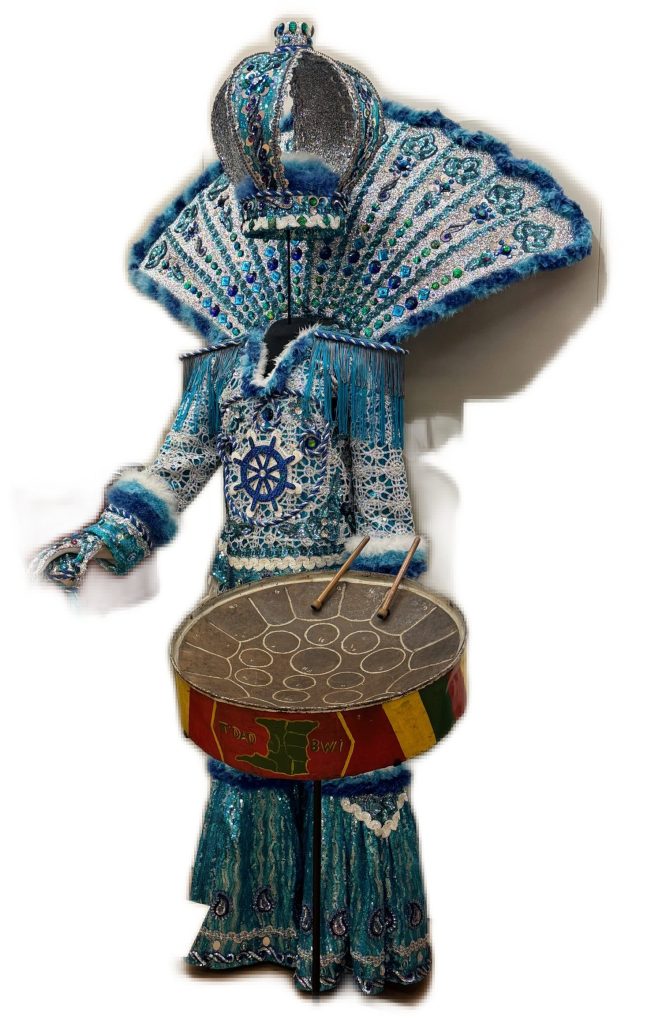
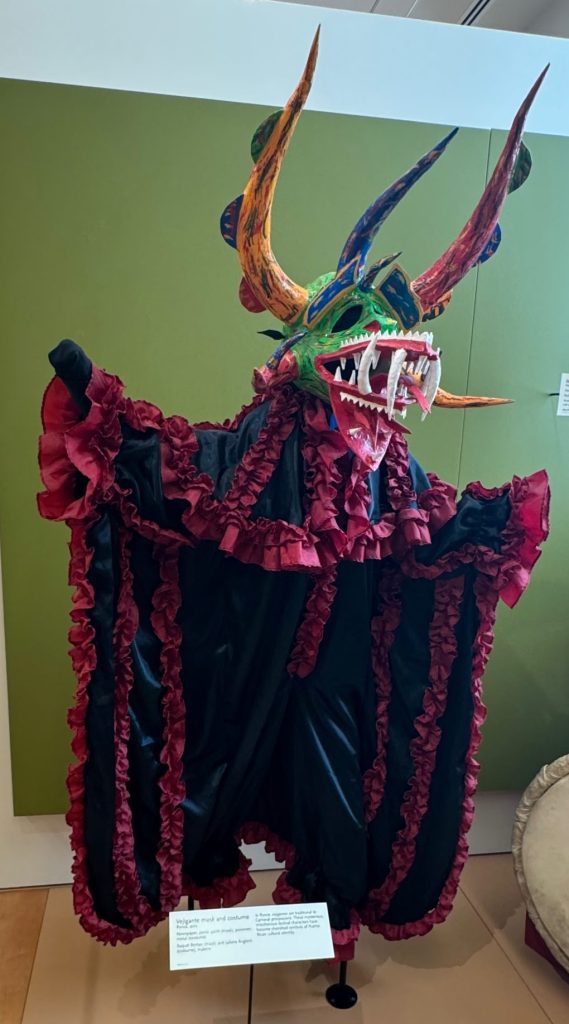
2.3. Music of the Caribbean
Various instruments are used to create the vibrant rhythms and melodies of Caribbean music. One unique instrument is the Steel Pans (or Steel Drums). These are percussion instruments made from metal oil drums. They are tuned to specific pitches and played with rubber-tipped mallets, producing melodic and rhythmic patterns. Other instruments include maracas (gourd shakers); djembe, bongo and conga drums; tambourines; steel guitars, various guitar-like instruments.
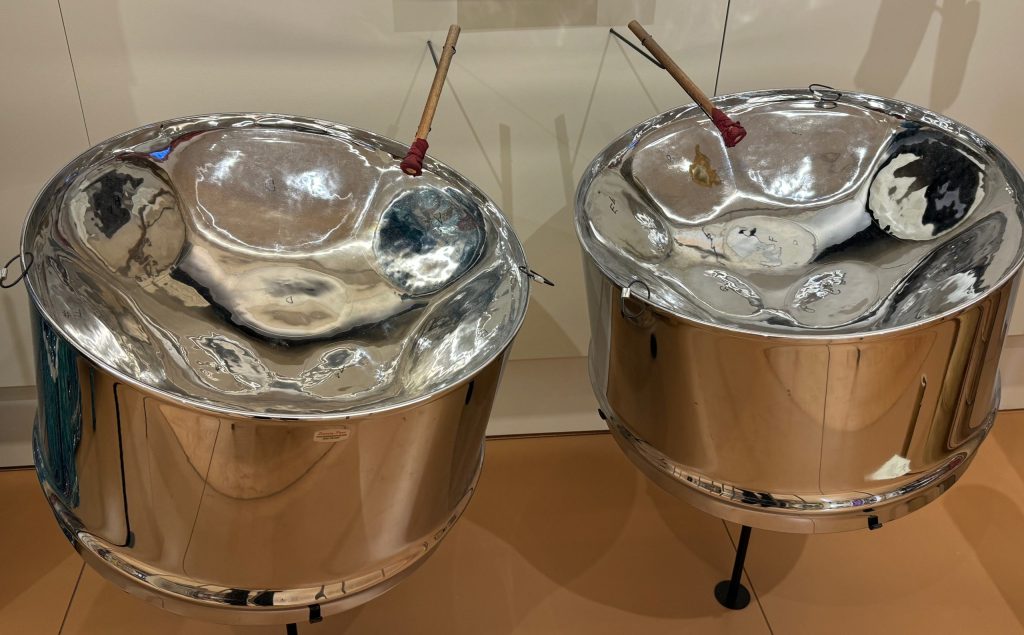
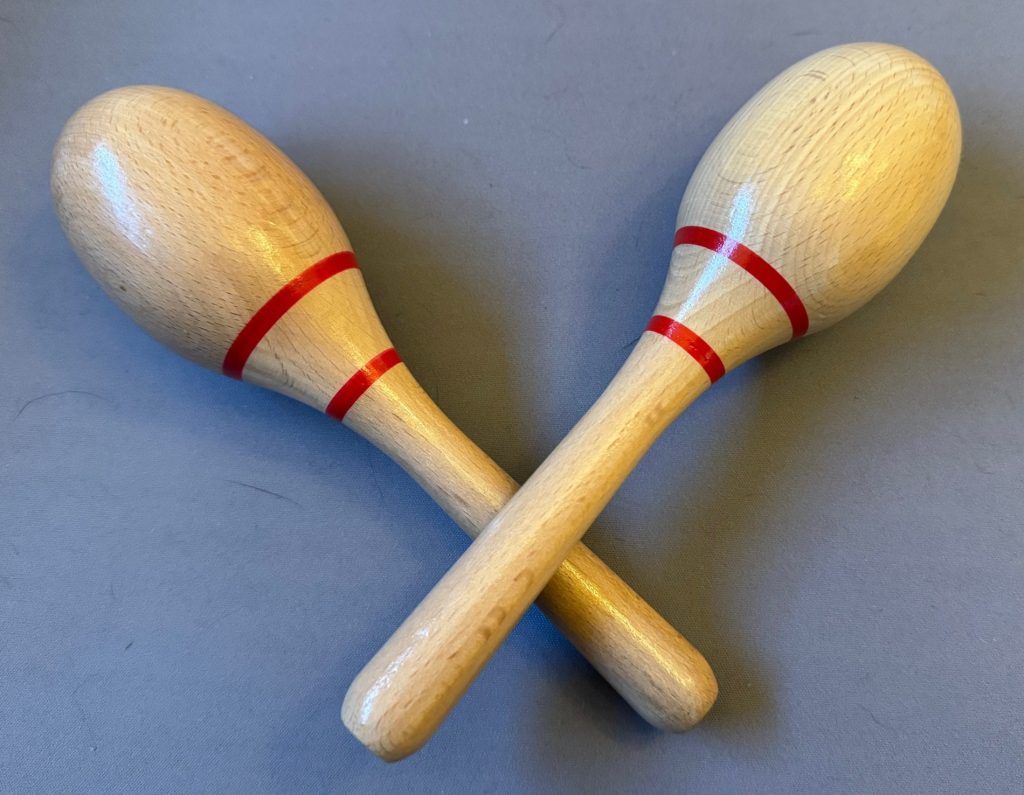
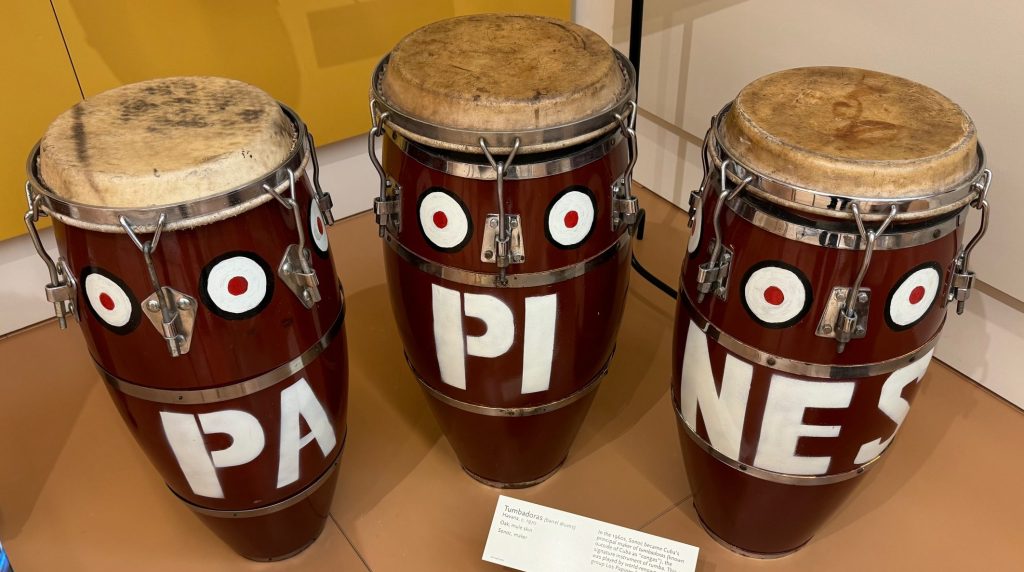
2.4. Trinidad and Tobago: Calypso and Soca
Calypso and Soca (soul of Calypso) are musical and dance traditions that originate in Trinidad and Tobago. Calypso and Soca often feature steel pan orchestras, syncopated rhythms, and call-and-response vocals. Soca is a high-energy music genre derived from calypso, incorporating elements of soul, funk, and Latin music. It features fast-paced rhythms, driving percussion, and celebratory lyrics, making it a favorite for Trinidadian Carnival festivities. Soca typically includes electronic instrumentation and synthesizers, giving it a modern and dynamic sound. Soca is a likely ancestor of American Hip Hop dancing. In many ways Calypso and Soca more closely resemble traditional dance styles of Africa than dances of the European colonizers. The styles are characterized by high leaps, hip shaking, twerking, arm swings and dramatic full body movements. The dances are usually done solo.
- Trinidadian Calypso: https://youtu.be/NHbaRyYesxY?si=VtfOJBr5-XOAfzLe
- Calypso: https://youtu.be/xHz_6MwpOPk?si=tQdC6FxTze_ThGvX
- Soca Dance: https://youtu.be/C9-xOePvqlY?si=RUZyE8XeraxO7jil
- Soca: https://youtu.be/2X8TMvvOnSY?si=RDhdkeRHVjgFcO6j
2.5. Jamaican music and dance styles: Mento, Reggae, Dance Hall
Mento is a traditional Jamaican music genre that predates ska and reggae. It features acoustic instrumentation, including banjo, guitar, and percussion, and is characterized by its catchy melodies, call-and-response vocals, and humorous lyrics. Mento often addresses everyday life, social issues, and folklore, providing insight into Jamaica’s cultural heritage. Reggae, Dance Hall, and Ska/Skank are other Jamaican musical and dance styles. Ska/Skanking originated in Jamaica in the 1950s. Ska combines elements of mento jazz, and rhythm and blues, featuring syncopated guitar riffs, brass instrumentation, and a driving rhythm section. Reggae is characterized by its laid-back rhythms, offbeat guitar strumming, and socially conscious lyrics. It emerged in the late 1960s and became associated with the Rastafarian movement, addressing themes of social justice, spirituality, and resistance. Reggae music often features deep basslines, syncopated guitar riffs, and the distinctive “one drop” rhythm. Dancehall emerged from reggae in the late 1970s. It features fast-paced rhythms, electronic instrumentation, and rapid-fire vocals (toasting) delivered by DJs (deejays). Dancehall lyrics cover a wide range of topics, including social issues, romance, and party culture. The genre has influenced numerous other music styles, including Hip-Hop and electronic dance music (EDM). Like Calypso and Soca, these dance styles show more influences from African dancing than from European sources.
- Dance Hall figures: https://youtu.be/IV0Mih6lwVc?si=jaeqS8vvrUy-34Sr
- Skank dancing: https://youtu.be/je8pT145gvs?si=PARmCYFjcs_XBQ6p
- Reggae dancing: https://youtu.be/stJA77t_THA?si=-MM-mXEsefE3ro6j
2.6. Dominican Dancing: Merengue and Bachata
Merengue features a distinctive marching rhythm, syncopated percussion, and accordion melodies. Merengue originated in the rural areas of the Dominican Republic, particularly in the sugarcane plantations and rural communities of the Cibao region in the early 19th century. It was initially played on string instruments such as the guitar, the cuatro, and the güira (a metal scraper percussion instrument). Merengue began as a social dance performed at community gatherings, festivals, and celebrations, including weddings, harvest festivals, and religious holidays. Merengue is danced in a close embrace, with partners facing each other and moving in a circular motion around the dance floor. Because it is done as a couple dance, it is our first example of a European-influenced Caribbean dance style.
- Merengue: https://youtu.be/JVOjIzGaTdE?si=LstM7ZY1KwNRvLPb
- The modern ballroom dance interpretation of Merengue: https://youtu.be/XZ5uBimAL8Q?si=g2AtQfcF_MgZB6OG
Bachata is another genre originating from the from the Dominican Republic, characterized by its melancholic melodies, romantic lyrics, and syncopated guitar rhythms. It has properties we can see in the early 20th century as a fusion of bolero, son, and merengue music styles. Bachata primarily evolved from the bolero, a romantic music and dance genre that originated in Spain. Bachata incorporates elements of bolero’s melancholic melodies, heartfelt lyrics, and rhythmic guitar accompaniment. In its early years, Bachata music was associated with poverty, marginalization, and social stigma in the Dominican Republic. It was often performed in informal settings, such as bars, brothels, and street corners, and was considered music for the lower classes. In recent years, Bachata has undergone a reevaluation of its cultural significance and artistic merit. It is celebrated as a symbol of Dominican identity, resilience, and creativity, reflecting the country’s rich cultural heritage and diverse musical traditions. Bachata dance is characterized by its slow, syncopated rhythm, hip movements, and intimate partnering. Bachata dancing involves close body contact between partners, with a focus on connection, musical interpretation, and improvisation.
- Bachata: https://youtu.be/q7cKWfcaAvY?si=zy1OB8Ex8nLPMpa7
- Bachata: https://youtu.be/_cFfvIHXgyM?si=fluYCZwzHXzzE4St
2.7. Dances from Cuba and Puerto Rico
Plena is perhaps the oldest dance style from Puerto Rico. Like Calypso, Mento, and Dance Hall from other islands it is primarily influenced by African dance styles. Although it can be done in partners, it is largely danced solo and the emphasis is on large dramatic movements, including swishing skirts as well as hip and shoulder movements. The music is heavily based in percussion.
- Plena: https://youtu.be/DR-zbsoS6_0?si=lv2gD3X-j7uq0oNq
- Plena: https://youtu.be/zfPkluCv8O0?si=3v9eIg3yIuBYmEzl
Rumba and Son Cubano are partner dances that originated in Cuba. They are characterized by slow, romantic rhythm, sensual hip movements, and intricate partnering. Son dancing involves close body contact between partners, with a focus on connection, musical interpretation, and storytelling. It incorporates elements of Afro-Cuban traditions and Spanish flamenco, but also incorporates brass instruments.
- Son: https://youtu.be/CgU3tXJGf-8?si=RmWswQodtuHc8nns
- Son: https://youtu.be/gsKQalDu4VU?si=GcIiF7jUA_TDutVw
- Modern Ballroom interpretation of Rumba: https://youtu.be/InwDNwxVO8s?si=Rad6wEX7UOwHNo-I
Mambo is a lively and energetic dance and music genre that originated in Cuba in the 1930s and 40s. It is characterized by its syncopated rhythm, intricate footwork, and dynamic partnering. Mambo dancing involves fast footwork, hip movements, and intricate turns, with partners moving in close embrace and performing flashy and expressive movements. It comes from the blending of African rhythms, such as the son and rumba, with European and Afro-Cuban musical influences. Mambo gained international recognition in the late 1940s and early 1950s, thanks to the efforts of Cuban musicians who traveled to the United States. They performed in New York City’s vibrant Latin music scene, introducing Mambo to American audiences. The Palladium Ballroom in New York City became the epicenter of the Mambo craze in the 1950s. It attracted dancers from diverse backgrounds, including Cuban immigrants, Puerto Ricans, African Americans, and white Americans, who came together to dance Mambo. Mambo music and dance reached new heights of popularity in the United States, thanks to the success of Mambo musicians such as Tito Puente, Tito Rodríguez, and Machito, as well as Mambo dancers such as Pérez Prado, Carmen Miranda, and Tito Puente. Although Mambo’s popularity waned in the latter half of the 20th century, its influence can still be felt in contemporary Latin music and dance. Elements of Mambo can be found in salsa, cha-cha-cha, and other Latin dance styles, which continue to evolve and adapt to new cultural trends.
- Mambo: https://youtu.be/xy9iIWvrMgk?si=b01j1Qih9haPNjFj
- A staged version of Mambo: https://youtu.be/dXpnuyqloKU?si=eHsorHqVJh6EDzk2
- Mambo from the Movie “Dirty Dancing”: https://youtu.be/BSaC8X7oNiA?si=gmQliB025YjnFbrK
- The Mambo Kings: https://youtu.be/jOtWmGhWp1g?si=2hujtXiIVl_171WZ
Cha-Cha-Cha is another playful and flirtatious dance and music genre that originated in Cuba. It is characterized by its syncopated rhythm, quick footwork, and lively hip movements. Today, Cha-Cha-Cha is danced in a close embrace, with partners moving in a forward-and-backward motion while maintaining a strong connection. It incorporates elements of mambo. It is particularly characterized by a particular rhythm of “Cha, Cha, Cha-cha-cha” or “one, two, three-and-four”.
- Cha Cha from the 1960s: https://youtu.be/TFNcXu3ozoI?si=zyKhYEm8r8ZGB5UK
- Classic Ballroom Cha Cha; https://www.youtube.com/watch?v=gw9L09AGaiU
- Modern Ballroom Cha-cha-cha: https://youtu.be/Rz55mgfxhxA?si=lQlE8Okhx-3CLLTJ
- Cha Cha from the 1964 Film “Cha-cha-cha”: https://youtu.be/WR89h24xGzk?si=50KhF9etwxX7WL5C
Perhaps the most famous style of dancing that originated in Cuba and Puerto Rico is Salsa. Salsa is a lively and sensual partner dance characterized by intricate footwork, rhythmic hip movements, and dramatic spins. The history of salsa dancing is closely intertwined with the development of salsa music, a genre that emerged from a fusion of Afro-Caribbean rhythms, jazz, and Latin American influences. In the mid-20th century, political upheaval and economic hardship in Cuba led to a wave of migration to the United States, particularly to New York City. Cuban musicians and dancers brought their cultural traditions with them, including the son, mambo, and cha-cha-cha. In New York, Cuban rhythms and dances merged with other influences, such as jazz, R&B, and Afro-Caribbean music, to create a new genre known as salsa. In the 1960s and 1970s, salsa music and dance became popular in New York City’s vibrant nightlife scene, particularly in neighborhoods such as the Bronx, Spanish Harlem, and Brooklyn. Salsa clubs and dance halls provided venues for socializing, dancing, and showcasing talent. Salsa dancers in New York developed their own distinctive style. Salsa dancing spread beyond New York City to other urban centers in the United States, Latin America, Europe, and Asia, fueled by immigration, tourism, and cultural exchange. Salsa festivals, workshops, and competitions helped popularize the dance worldwide. As salsa dancing spread globally, it diversified into different styles and variations. Each style has its own unique characteristics, choreography, and musical interpretation.
- Modern ballroom salsa dancing: https://youtu.be/0_URQwRrgB8?si=QgflWOVO5ZaOXD1G
- Social Salsa Dancing: https://youtu.be/be2rmxVRJpI?si=5sT6vGKdWwmqqQPA
- Social Salsa Dancing: https://youtu.be/3tWkUiSkoOc?si=AFlhnPCls5MSs17x
- Salsa Dancing: https://youtu.be/tBEc9Kni6I0
One particularly interesting style of Salsa is the Rueda de Casino, commonly known as Rueda, is a form of salsa dancing that originated in Cuba in the late 1950s and early 1960s. It is a group dance performed in a circle (rueda means “wheel” or “circle” in Spanish) and is characterized by frequent partner changes and synchronized movements. One really interesting part of Rueda is the fact that unlike other varieties of Salsa. The figures are not improvised. Instead, there is one dancer who calls the figures for all the other dancers like a caller as in a square dance.
- Rueda: https://youtu.be/L8QAgsztmPw?si=APo4i-InOy6tXUxS
- Rueda Flashmob: https://youtu.be/4sPR_XNTDs0?si=EcT3T1UH7gCVdwRJ
- Rueda in Cuba: https://youtu.be/yS58jwxQPFg?si=A48vj6V4p8FfP7K3
2.6. Caribbean Quadrilles
All of the Caribbean dance styles we’ve discussed thus far have be a result of Spanish or African influence. But the French style of square dances known as the “Quadrille” were also influential particularly in those regions with former French colonizers, such as Martinique and Haiti. These dances are done by the descendants of African Slaves in these countries, but the figures are essentially those of French Court dances and American Square dances. The music for these quadrilles is typically Caribbean, slow and languid with calypso, zouk or reggae beats and use shakers and African drums for percussion. Although the dancers in Caribbean Quadrilles do many of the figures found in other square dancing traditions, they rarely touch each other or the other dancers. The women wear long colorful dresses and the men often wear plaid or solid colored vests. The women almost always carry a fan in their left hands and the men fan themselves with a straw hat. The dances are often done barefoot.
- Quadrille Haute Taille from Martinique: https://youtu.be/EFyJ2zR6V7c?si=LnfQSrdcQhlkaS3p
- Quadrille from the US Virgin Islands: https://youtu.be/__KjciBBphg?si=SxhwN2u3jWfXBv6I
- Haitian Quadrille in the 1950s: https://youtu.be/NhYB1_0Oft8?si=i8raiTOEjwxWh1X2
3. Mexico
3.1. History and Geography
While culturally Mexico shares many attributes with its Latin cousins in Central and South America, it is geographically part of North America. However, because of the cultural ties with the rest of Latin America, we discuss it in this chapter rather than in the chapter on North America.
Mexico is bordered to the north by the United States, to the south and west by the Pacific Ocean, to the southeast by Guatemala, Belize, and the Caribbean Sea, and to the east by the Gulf of Mexico. Mexico is has a number of geographic regions, including deserts in the North, highlands and mountain regions of the center and tropical rainforests in the south.
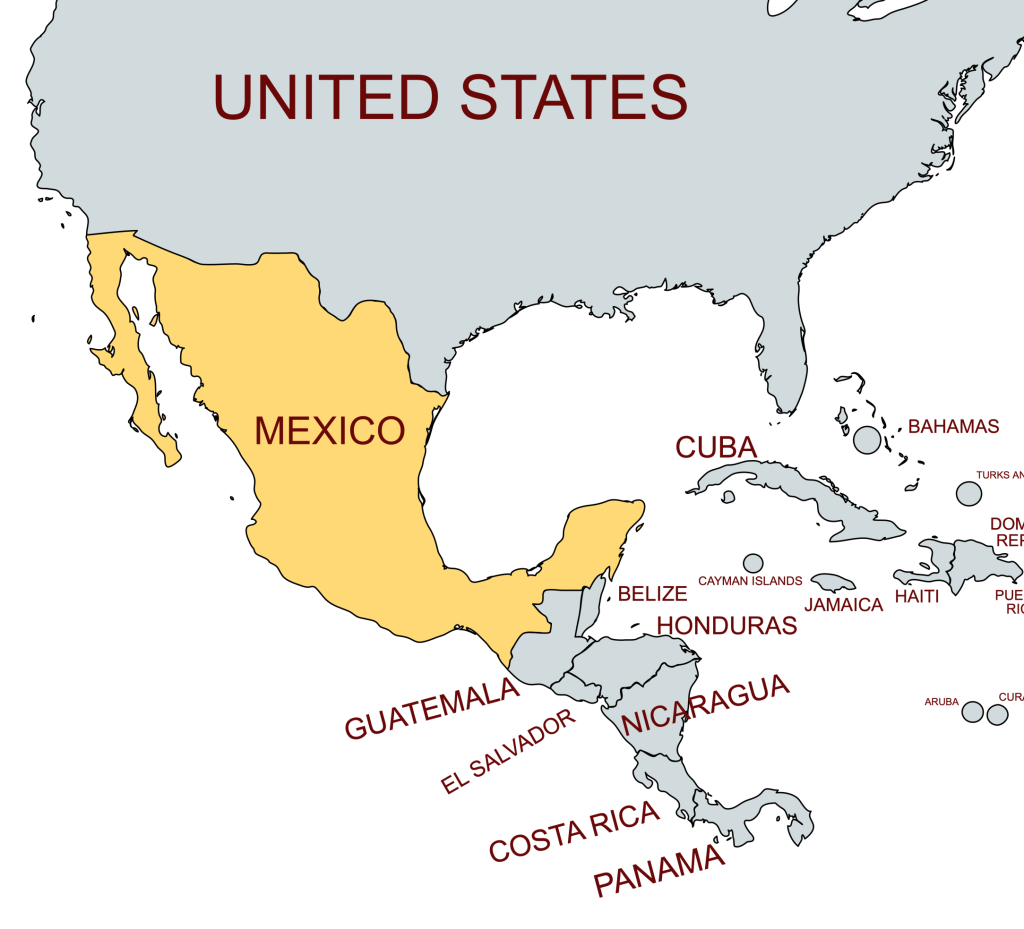
Mexico was the home of several different ancient indigenous civilizations. The Olmecs (c. 1200-400 BCE), are now known for their colossal head sculptures and early developments in writing and urban planning. The Maya flourished from c. 2000 BCE to 1500 CE, known for its sophisticated writing system, art, architecture, and astronomical knowledge. The Aztecs dominated central Mexico from the 14th to 16th centuries, with their capital in Tenochtitlan. Today, about 23 million people in Mexico identify as indigenous, which is approximately 21.5% of the population. This does not include the large population of Mestizos who are people of mixed indigenous and European descent. Mestizos constitute the majority of the Mexican population and have a significant influence on the country’s culture, politics, and society. Estimates suggest that about 62% of Mexicans identify as Mestizo. Racial and ethnic identities in Mexico are often fluid and complex, with significant regional variations. Social class and cultural assimilation also play crucial roles in how racial identities are perceived and expressed. Despite the blending of cultures, there are still social and economic inequalities. Indigenous and Afro-Mexican communities often face higher levels of poverty and marginalization. Land tenure issues, including lack of legal recognition of ancestral lands and disputes over natural resource extraction, threaten indigenous communities’ livelihoods and cultural survival. Many indigenous languages in Mexico are endangered due to factors such as language shift, assimilation, and limited institutional support. Efforts to preserve and revitalize indigenous languages are crucial for maintaining cultural identity and intergenerational transmission of knowledge
Indigenous civilization in Mexico was brought to crashing and disastrous end with the arrival of Hernán Cortés in 1519. By 1521, he had conquered and subjugated the Aztec Empire. Mexico became part of the Spanish Empire, known as New Spain. Spanish rule brought significant social and economic changes, including the introduction of Christianity, the encomienda system of forced labor and tribute taxes, and extensive mining. Led by figures like Miguel Hidalgo and José María Morelos, Mexico fought for and achieved independence from Spain in 1821. The newly independent Mexico struggled with political instability, regional conflicts, and economic challenges. The country saw numerous changes in government, including the short-lived First Mexican Empire and the establishment of a republic.
The territory of Mexico used to be much larger and include what are now large parts of the United States, including California, Arizona, New Mexico and Texas. In the 1830s, Texas declared independence from Mexico, leading to the Mexican-American War (1846-1848). The war ended with the Treaty of Guadalupe Hidalgo, through which Mexico lost about half of its territory to the United States. In 1910, there was a large scale revolutionary conflict, led by people such as Francisco Madero, Emiliano Zapata, Pancho Villa, and Venustiano Carranza. It resulted in significant social and political changes and the drafting of the 1917 Constitution. Today, it is a vibrant democracy, albeit one which still sees many social inequities resulting in significant outward emigration.
3.2. Mexican Folk Costumes
There are number of characteristic regional costumes in Mexico.
In the western state of Jalisco – the region most commonly associated with Mariachi music, the women wear a long, brightly colored dress with a fitted bodice and a full, ruffled skirt, often in colors like red, blue, or green. The skirt is decorated with multiple ribbons and lace, creating a layered and festive appearance. The skirt is typically held out to the sides and is swung around in beautiful patterns. Hair is typically styled in braids with ribbons and women wear matching bows and earrings. The men from Jalisco wear the characteristic Traje de Charro, which is a fitted suit with a short jacket, slim trousers, and intricate silver or gold embroidery. They wear a white shirt with a large bow tie or cravat, boots with spurs and a decorative belt. Most characteristically they wear a very large, wide-brimmed hat called a sombrero.
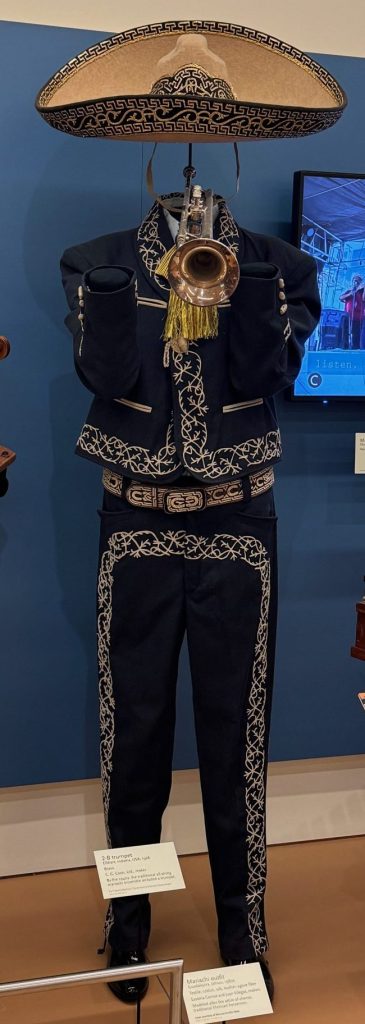
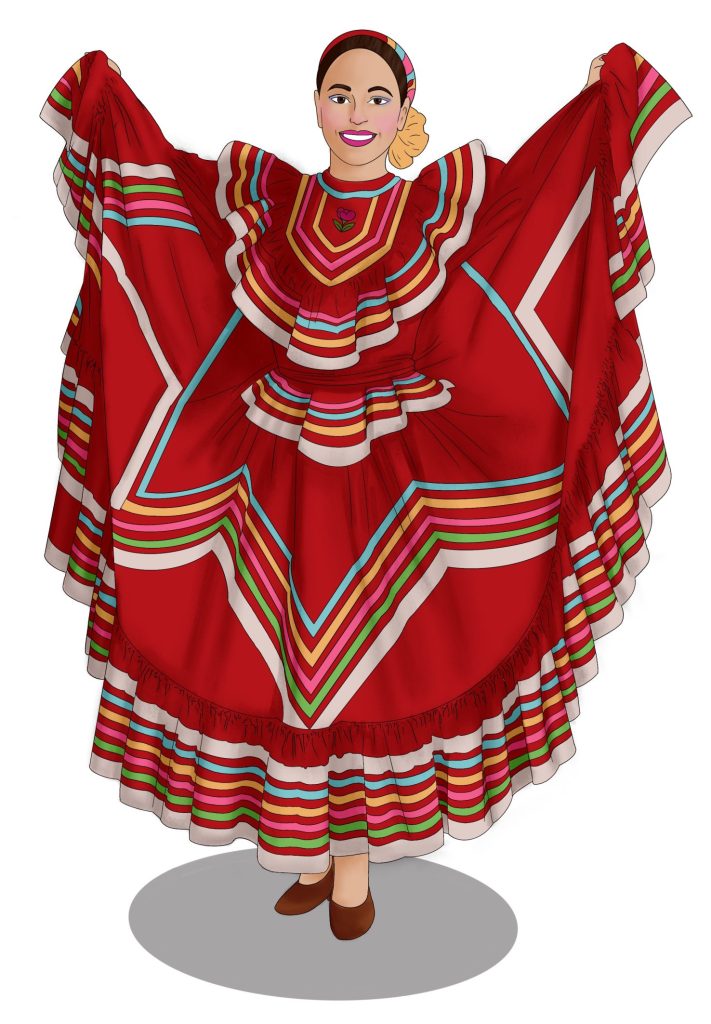
In central Mexico (Puebla) one sees the women wearing China Poblana, which is a long, wide, and heavily embroidered skirt, often featuring colorful floral patterns and sequins. This is accompanied by a white blouse with intricate embroidery, lace, and ribbon detailing. This is worn with a rebozo, which is a shawl or scarf that is draped over the shoulders, often made of silk or cotton and matching the color scheme of the skirt.
In Oaxaca, women wear Tehuana Dress, which consists of a Huipil, a richly embroidered, loose-fitting tunic or blouse; An enagua, which is along skirt with intricate embroidery and lace; and a resplandor, which is a large, lace headdress worn over the head and shoulders, framing the face.
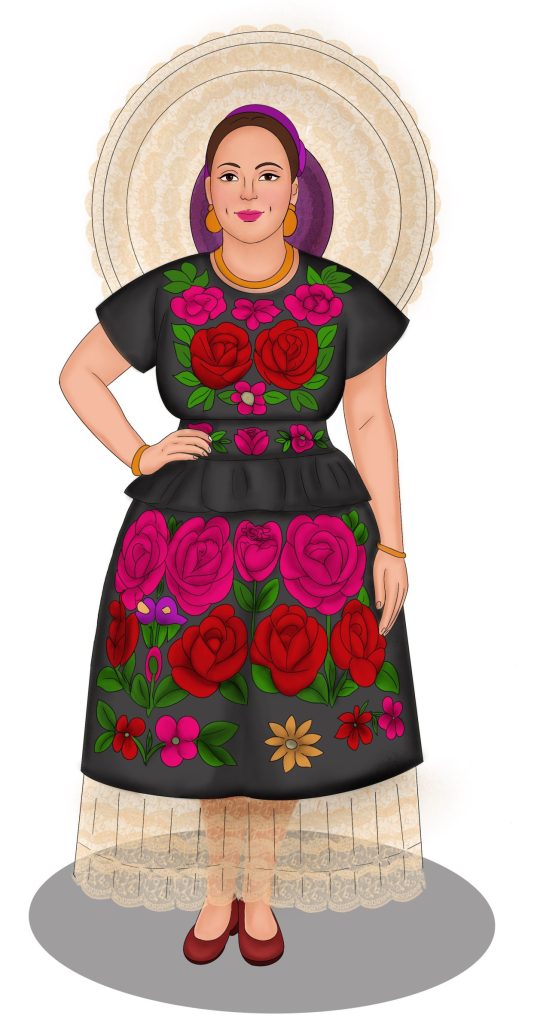
In Veracruz , women wear the Traje de Jarocha, A white lace dress with a full skirt and a fitted bodice, often adorned with ribbons and embroidery. This is accompanied by the delantal, a black or colored apron with floral embroidery and a Rebozo, a colorful shawl, often draped over the shoulder. Men wear a white linen or cotton guayabera shirt with embroidery and pleats, paired with white trousers. They wear a straw Sombrero de Paja on their heads and a red bandana tied around the neck. The men’s costume is fairly standard around Central America and the Caribbean.
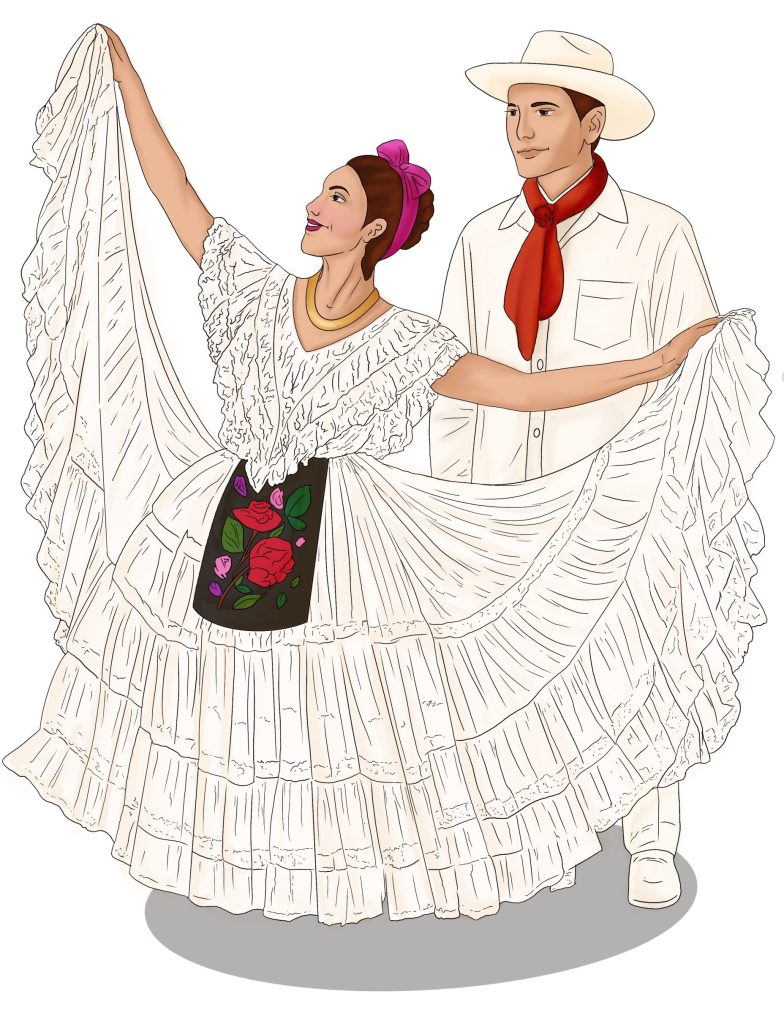
These are just a few of the regional costumes of the country.
3.3. Mexican folk music
When most people think of Mexican music, they think of the style called Mariachi from Jalisco. It is instantly recognizable by the significant use of trumpets, violins and harps. Other instruments include the Guitarra de Golpe, the guitarrón (large bass guitar), the vihuela (small guitar), guitar, violins and sometimes harp. Mariachi is often paired with Ranchera. Ranchera is primarily a sung variety where the songs deal with themes of love, patriotism, and nature. Closely related to Mariachi is Banda from Sinaloa
- Mariachi – El Cascabel: https://youtu.be/mDZG-BM3AoI?si=eFIcgzLXdE7AVQpa
- Mariachi – El Siquisiri: https://youtu.be/dXvKPexDrVg?si=TC3ictQpjhfZ-NL4
- Ranchera Music: https://youtu.be/NVfg5NdJeN4?si=9PuT9ajirjN3Y8vw
- Banda – Soy Tarasco: https://youtu.be/kOPO8tPm2dw?si=CZHd2kFl1Y0FRph6
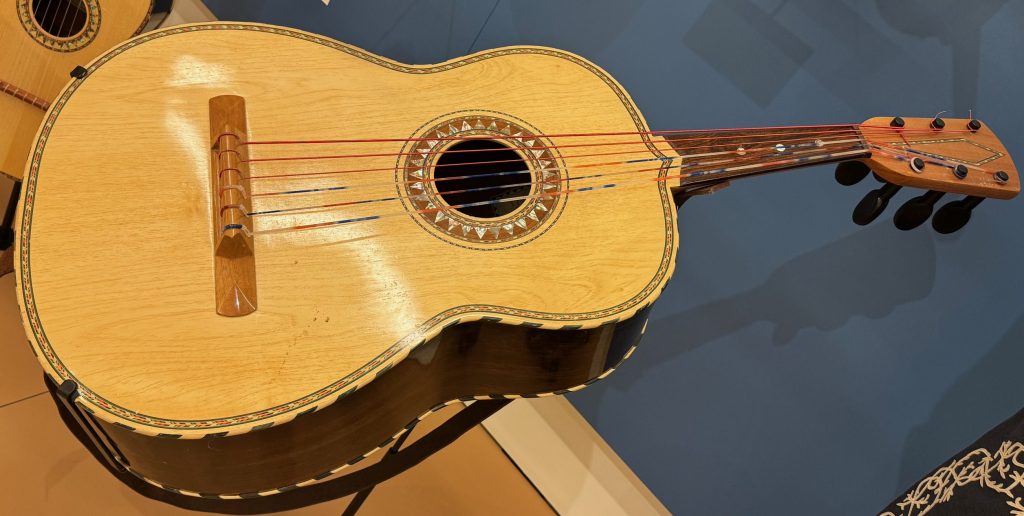
Corridos are narrative ballads that tell stories of heroes, outlaws, love, and historical events. They often have a strong moral or political message. In modern times, one style of Corrido that has become prominent are the Narcocorridos, which sing the praise of drug gangs and drug smugglers, while at the same time being based in traditional waltzes and polkas.
- Corrido de Daniel Del Fierro: https://youtu.be/fAVHjEiNK48?si=VYEpUQoLWIAo_sjL
- El Número Uno Corrido: https://youtu.be/Y3bCk_K_nJ8?si=xOkdVRmNVqUG_TJZ
- Narcocorrido- Corrido de Juanito: https://youtu.be/pC7a27zE2fs?si=3eeaulXTqLDYB57e
- Narcocorrido- Los Sinaloenses: https://youtu.be/WSXNZ3XhYO0?si=_ZMFoWeDKEbp9YI9
Son Jarocho is a musical style from the Veracruz region. It uses the jarana (small guitar), requinto (high-pitched guitar), harp, marimbol (a large wooden box with metal tongues, played by plucking), and various percussion instruments. It features a mix of syncopated rhythms, call-and-response vocals, and improvisation. The famous song La Bamba is an example of Son Jarocho.
- Son Jarocho: https://youtu.be/tqkkiSno8nI?si=mw9qZpKThlRRrEbe
- Son Jarocho: https://youtu.be/xFxDh6G98M8?si=951cAZ67xKC-rc-q
- La Bamba: https://youtu.be/cXvtL0xud7Y?si=CEQ8XwDlJAR5aDkQ
Norteño comes from northern Mexico, especially in the states of Nuevo León, Tamaulipas, and Coahuila. The most important instrument is the button accordion, but it also uses the bajo sexto (a twelve-string guitar), bass, drums, and sometimes saxophone. Norteño music features a strong European polka influence. The lyrics often tell stories of rural life, love, and social issues. A closely related style is Tejano music, which comes from Texas and also uses the accordion as its main melodic instrument. The famous cross-over artist Selena often sang in a Tejano style.
- Norteño -Adios Amor: https://youtu.be/ETLoTxVVvjM?si=d3apcjeVrGJZnq-4
- Norteño -Tú: https://youtu.be/pnOP7wbPXqY?si=LkM2WlrQuVkdkDQ9
- Tejano – Selena: https://youtu.be/5ZQ3lMpwsu8?si=wHtQRbu0aVXcrYCv
- Tejano – Accordion Power Players: https://youtu.be/Zc1ZXm-rFLA?si=qTPY1hp_tcb-TueT
This short survey only scratches the surface of different types of Mexican music. There are many other regional styles of Mexican music including Son Istmeño from Oaxaca and Huapango from Huasteca.
3.4. Traditional Dances of Mexico
One can still find dancing that is based in indigenous traditions. For example, Concheros dance has roots in pre-Hispanic indigenous traditions.The music is heavily percussive and uses conchas (stringed instruments made from armadillo shells) and flutes.
- Concheros: https://youtu.be/CkKVVD_-XFo?si=-y3mozKjdRPreVHc
- Concheros: https://youtu.be/C-XaKA7OBBY?si=5z8TK6rpwv8tSf7I
- Concheros: https://youtu.be/2FCSOMjHLU8?si=vCCt5zoF1LV5-o3v
The majority of Mexican dance styles, however, are highly influenced by European dance traditions, especially waltzes, polkas and schottisches, but also stamping and stomping dances which show influences of flamenco.
The Jarabe Tapatío, a.k.a. the Mexican Hat Dance, is perhaps the most iconic Mexican folk dance. Originating from Jalisco, it involves intricate footwork, graceful movements, and vibrant costumes. The dance often features a male and female couple who flirt and compete with each other, while dancing around a sombrero.
- El Jarabe Tapatío: https://youtu.be/0CRSIjT0sYY?si=Qre8xc11O2MY-0Ex
- El Jarabe Tapatío: https://youtu.be/XldQV6Md1Pc?si=P8qa5EJY1Dt_Dpa6
- El Jarabe Tapatío: https://youtu.be/-x0vKSO29N4?si=09D7bDXwM9I5rkbw
The dances from Vera Cruz often involve impressive use of props. La Bamba involves taking the man’s sash, dancing around it and on the floor and tying it into a knot. La Bruja is a waltz where the women slowly spin around while balancing a candle on their heads.
- La Bamba: https://youtu.be/dq7bJ-xP2EE?si=1nr7ydR2qlkuMlMk
- La Bruja: https://youtu.be/GAKWY-EHzaQ?si=brE8MuotLel1ji9I
- La Bruja: https://youtu.be/LJ2s1btOTRA?si=xX2l5Dp4ZedG-tNv
La Danza de los Viejitos (The Dance of the Old Men) from Michoacán is a funny portrayal of old men. Dancers wear masks, colorful clothing, and use canes as props, showcasing the vitality and joy of life.
- La Danza de los Viejitos: https://youtu.be/_iFCHMJZaTw?si=rksvtbqJKYxxfcRf
Many Mexican dances tell stories. La Conquista reenacts the Spanish conquest of Mexico. La Danza de los Diablos, from state of Guerrero, portrays the battle between good and evil. Dancers wear elaborate devil masks and colorful costumes, performing acrobatic moves to the beat of drums. Another storytelling dance from Guerrero is Los Tlacololeros celebrates agricultural traditions. Dancers, dressed as farmers, perform movements imitating planting and harvesting while carrying various props.
- La Conquista: https://youtu.be/cOePh0MMzR8?si=Y9VNZ_QW2g-ZFxh4
- La Danza de los Diablos: https://youtu.be/IIQfU7N84gw?si=_vGn1b5h0TAQV0Xw
- La Danza de los Diablos: https://youtu.be/hzFT1kRDMuQ?si=-pbXaWR4ul9Z1Esb
- Los Tlacololeros: https://youtu.be/4tLYRSqxYlg?si=zh2qqfOd2TcuDi7g
4. Central America
4.1. History and Geography
The countries located between Mexico and South America, known collectively as “Central America”, include Belize, Guatemala, Costa Rica, El Salvador, Honduras, Nicaragua, Costa Rica, and Panama.
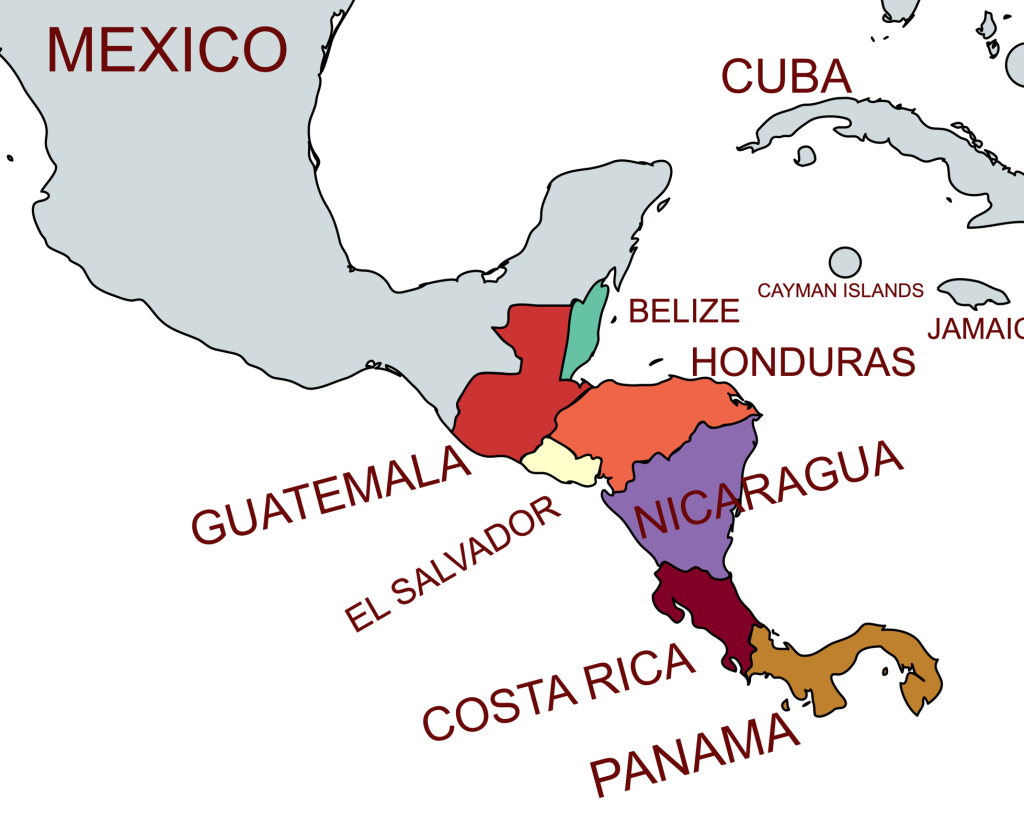
The history of Central America is very similar to that of Mexico. We find sophisticated indigenous civilizations throughout the region before the conquest. This was followed by brutal colonial occupation with the ravages of disease, violence, slavery, and assimilation. This was followed by generations of revolution and corruption. In recent history, these countries have been subjected to both right wing and communist dictatorships, some of which continue into current times.
4.2. Central American Folk Costumes
The costumes of Central America show many similarities with those of their Mexican and Caribbean neighbors.
As in Mexico, women of Maya background wear the Huipil and Corte. The Huipil is a hand-woven blouse, often adorned with intricate embroidery and patterns specific to the wearer’s village. The corte is a long wrap-around skirt held in place with a woven belt called a faja. Other women’s costumes include long, flowing, and richly embroidered skirts and Rebozo shawls.
Men’s costumes typically use the ubiquitous guayabera shirt found throughout the region. They often also wear white pants, white shoes, a straw hat, and a red bandana tied around the neck.
4.3. Central American Music
The music of the region is also heavily influenced by their neighbors in Mexico and the Caribbean. We see extensive use of button accordions, various kinds of guitars, violins, and brass instruments. However, there are also some instruments unique to the region, many of which have indigenous origins.
The Marimba is very common instrument in the region. It is xylophone-like instrument played with mallets. It produces a rich, resonant sound.
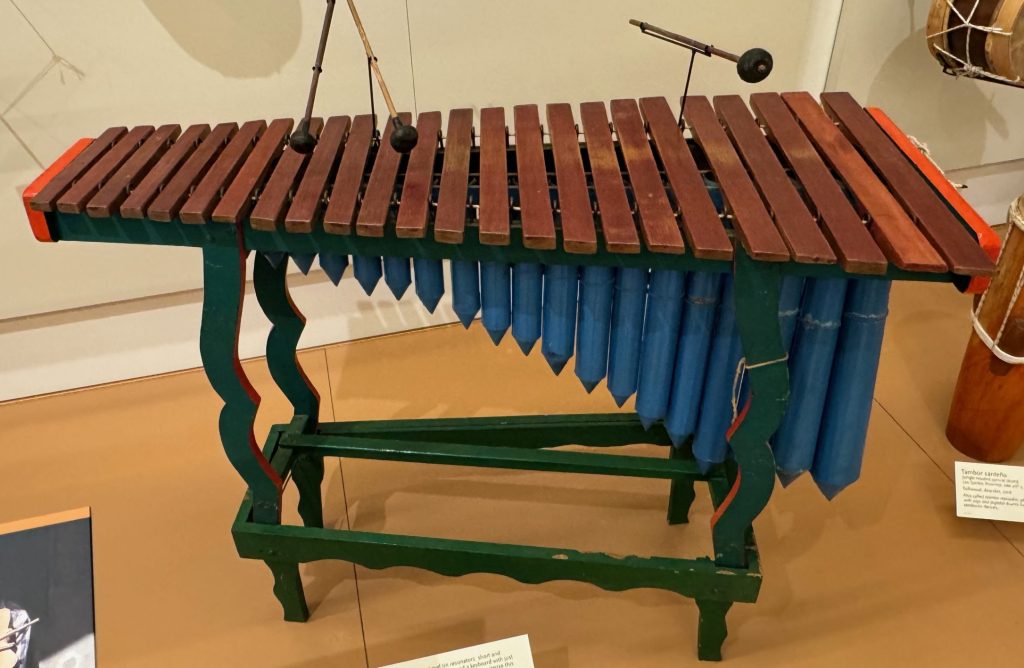
We also find unique wind and string instruments including the chirimía: a type of double-reed woodwind instrument, similar to an oboe, used in traditional Mayan and Mestizo music; the conch shell, used as a wind instrument, producing a deep, resonant sound; and the ocarina – an ancient wind instrument made from clay or ceramic. The quijongo is a single-stringed instrument played by striking the string with a stick, producing a haunting, resonant sound and the rabel, a type of fiddle used in traditional Panamanian music. In terms of percussion, we have Maracas; the guiro, which is percussion instrument made from a hollowed gourd with notches, played by scraping a stick along its surface; timbale and tamborito drums; and drums made from the shells of turtles.
4.4. Dances of Central America
There are vestiges of traditional indigenous and traditional African dances in a lot of traditional folkdances. The Garifuna people of Honduras, who come from a mix of Arawakan and African backgrounds do a dance called Punta. Punta is done primarily to drumming and involves rapid hip movement.
- Punta: https://youtu.be/hxsMQyaKWpw?si=DbVTY35Ml7mkkamC
- Punta: https://youtu.be/2X2jZd3JDtM?si=SBnwRUaCPqUFkCZy
- Punta: https://youtu.be/70teseguCFY?si=MLLZbX9zlgFhR-y6
Many dances tell stories or are danced plays. Danza de los Moros y Cristianos is from Guatemala. It is a dance-drama that reenacts the battles between the Moors and Christians during the Spanish Reconquista. It involves elaborate costumes and masks. Also found in Mexico, we see the Baile de la Conquista. A dance that dramatizes the Spanish conquest of Central America. There are also older story telling dances, such as the Rabinal Achí, a pre-colonial Mayan theatrical dance that narrates the capture, trial, and execution of a prince. El Güegüense, from Nicaragua, is a satirical drama combining music, dance, and theater, portraying the cleverness of a mestizo trader who outsmarts Spanish authorities.
- Danza de los Moros y Cristianos: https://youtu.be/qbKTlnsYhAk?si=RP0gGxRZbM08PP6a
- Baile de la Conquista: https://youtu.be/TrVTkHW4q5E?si=NGUKDWqRhQONPNZs
- Background on the Rabinal Achí: https://youtu.be/XJbJO4Co4Rs?si=UhS2Xs2LbZ97vuc6
- Rabinal Achí: https://youtu.be/mv1sh7LIXK0?si=f9goAZPiqsemBUvW
A related genre of dance highlights professions. Las Cortadoras is a dance that mimics the actions of coffee pickers, depicting the importance of coffee cultivation in Salvadoran culture. La Cajeta, from Costa Rica. is a dance that simulates the process of making cajeta (a sweet made from milk and sugar. Los Toritos Pintos is a lively dance from El Salvador depicting a bullfight, where dancers imitate the movements of a bull and a bullfighter.
- Las Cortadoras: https://youtu.be/6nfX8rJDEjA?si=6vVs1JqkDT9g8Wzm
- La Cajeta: https://youtu.be/wPPTm56Q5zc?si=11QoWTNp0fVVVDnz
- El Torito Pinto: https://youtu.be/HGEV9D67nYo?si=aQnOv_ztyrIbMa-q
There are, of course, many dances with strong European origins. In Honduras, they dance their own version of the polka. Son Guatemalteco is also a polka usually played on the marimba, guitar, and sometimes the chirimía. But unlike the Honduran La Polka, the partners don’t hold each other in a ballroom hold. Instead, they circle around each other. In Nicaragua they have adopted the pan-European tradition of Maypole dancing, called Palo de Mayo, but set to Caribbean music. El Tamborito, from Panama, is dance performed to the beat of drums (tambores) and clapping, involving call-and-response singing.
- Tamborito https://youtu.be/9LDZG72X26U?si=c9N–7s0lyS8Po8H
- Tamborito: https://youtu.be/98i1R2tWqM0?si=BquOPw_ab01LPCTk
- La Polka: https://youtu.be/p9NsSo5bWEk?si=0hWgWJkirz6xbu9m
- Palo Mayo: https://youtu.be/ne1iawC-u-Q?si=dIo6jE-yBqtYL_U3
- Son Guatemalteco: https://youtu.be/fl4E9YmbcgY?si=PjZsajYg2p8Os_6W
5. Indigenized Dance Traditions
Indigenized dances are a fascinating phenomenon. A dance tradition that is borrowed from the colonizer into an indigenous culture and then given a unique spin that is consistent with the world view, music and cultural traditions of the indigenous group is said to be “indigenized”. We already spoke of the phenomenon in the Chapter on North America when it came to the clogging tradition of Red River Jigging. Arguably, the quadrilles of the French Caribbean mentioned above may also be indigenized forms. In this section, we discuss two further examples: The Pascua Yaqui Easter ceremony and Waila dancing, both of which are European-influenced dance traditions found in the indigenous communities in Southern Arizona.
5.1. Pascua Yaqui Matachines
The Pascua Yaqui (also known as Hiaki and Yoëme) are an indigenous group whose traditional homeland is in the state of Sonora in Mexico. Historically their travels for work and trade often took them to the Southwestern US, where small migrant communities in California, Texas and Arizona gradually became permanent settlements, particularly following genocidal policies and war with the Mexican government in the early 20th Century. The Arizona tribe received the moniker “Pascua” (Easter in Spanish) because of their famous dance-drama that reenacts the events surrounding the crucifixion and resurrection of Jesus Christ. The broad outlines of the story being portrayed obviously came with the religious evangelism that accompanied the Jesuit missions brought in by colonial powers. However, it has taken on some unique native story elements. For example it incorporates the deer dance, which traditionally was a ceremony intended to convince a deer to sacrifice himself to the hunters for the welfare of the tribe. At the very end of the ceremony is a dance of the Matachines Society, which has been linked to “Moorish” traditions in Spain and may be related to Morris dancing in England. Although Matachines use rattles rather than sticks in the performance, many of the figures, such as the do-si-do are clearly from European traditions. They even do a European style maypole dance. The Easter ceremony is part of the larger family of dance-dramas found throughout Mexico and Central America, including the dramas discussed above about the conquest of the Americas by the Spanish, and the battles between the Moors and Christians in Spain. This dance drama, however is particularly elaborate and literally takes weeks to perform.
- Yaqui Deer dance: https://youtu.be/doaFfzMbNeQ?si=b6x6xppQpR0zcgjS
- Matachines Danza: https://youtu.be/L74qEvBq-PM?si=65n-E6egIkQkN2f7
- Information on the Yaqui Easter Ceremony: https://youtu.be/rbPYvB8sczE?si=KF4CcTO-ZlO3MRpf
- Matachines Maypole dance:
- Documentary on the Ceremony from the 1940s: https://youtu.be/9Mavi3IdPUI?si=uRtwsmWh9K1ujAh4
5.2. O’odham Waila Dancing
The other group of indigenous people who live around Tucson and Phoenix are known as the O’odham (formerly called the Papago and the Pima). Tucson is built on the occupied land of the Tohono O’odham and Phoenix is built on the lands of the Akimel O’odham. The O’odham people have a very unique tradition of music and dance known as Waila (from the Spanish Bailar ‘to dance’). The music, also known as “Chicken Scratch”, is based in Spanish and German polkas, waltzes and schottisches. Traditionally it was played on fiddles accompanied by native percussion, but now Waila music is heavily electrified and played on Mexican style accordions, saxophones, electric guitars and drum kits.
- Old Style O’odham Fiddle Music: https://youtu.be/GWpHBCAa3qI?si=YG6dj4HOcYMtMQSA
- Modern O’odham Chote: https://youtu.be/cfccw-hxhaw?si=OwoAI__4pJin4oEX
- Modern O’odham Cumbia: https://youtu.be/7jsgpJQTKkc?si=aEetjceTxMuBMQXp
- Modern O’odham Waila (Polka): https://youtu.be/nwk06ruZn7I?si=jL_AguxtL_msw48f
- Modern O’odham Mazurka (Waltz): https://youtu.be/hZP7vpS19fY?si=dHq7GS1ln7ipiYrK
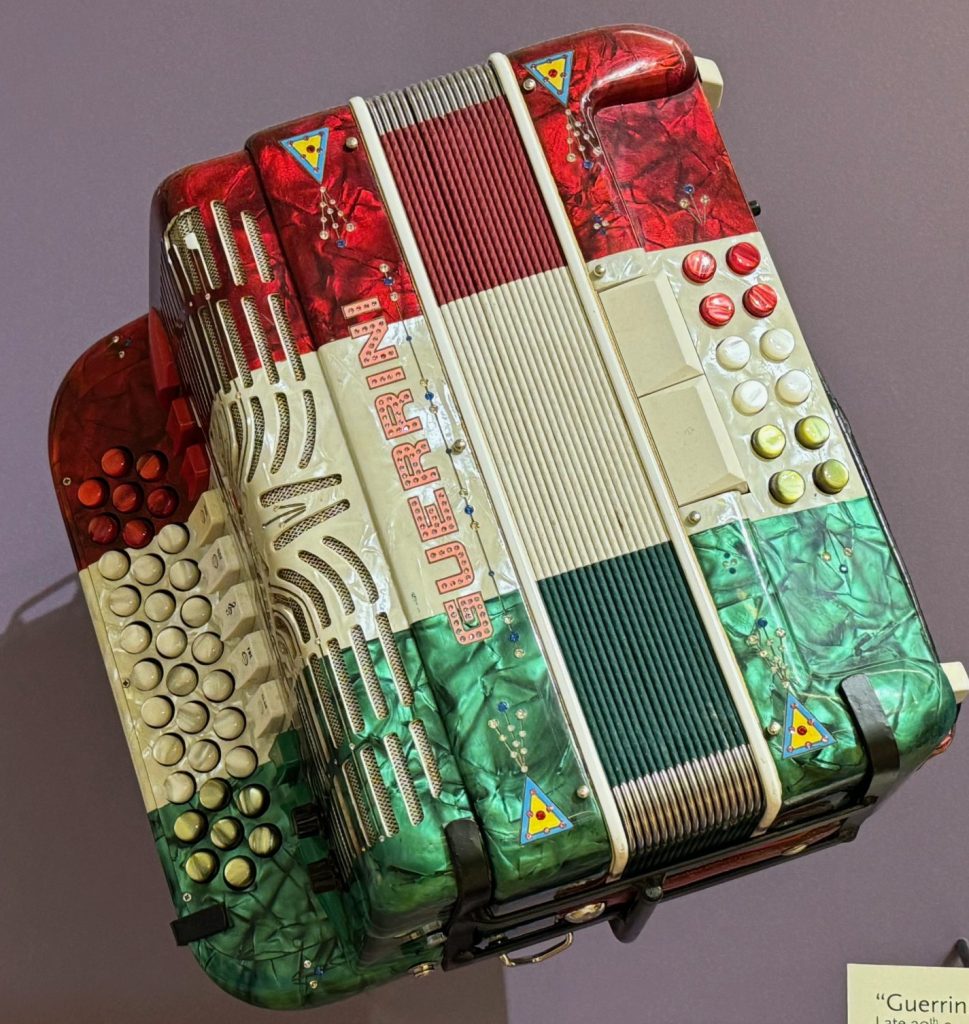
Waila dancing is almost entirely based in European traditions. The four most common dances are Waila, which is a walking polka; the Chote(from Schottische) which is a dance similar to the western two-step; the Cumbia, which is a group dance borrowed from South American traditions, and the Mazurka, which is done in a Waltz (3/4) rhythm. The dances are done with a unique heavy and low-to-the-ground style, appropriate for dancing in the hot desert in a dusty courtyard, so as not to expend too much energy and to avoid kicking up too much dust. There are two versions of the Mazurka, one which is a typical 3-step dance that fits the music, but the other is a unique version where you do a 4-beat footwork sequence against a 3 beat measure. This means that the footwork crosses over the musical measures.
- Waila dancing (Tohono O’odham): https://youtu.be/DE3_bxbOlGY
Further Reading
- Duggan, Schlottman and Rutledge (1948), Johnston (1935), Phlorec (1980), Carty (1988), Bottomer (1996), Covarrubias (n.d.). See the references at the end of this book for full citations.
- https://en.wikipedia.org/wiki/Skank_(dance)
- https://www.rimjournal.com/arizyson/easter.htm
- https://www.nmarts.org/matachines/essays.php?p=torres
- https://en.wikipedia.org/wiki/Matachines
Some Suggested Dances for Teaching
- La Raspa (Mexico): https://folkdancemusings.blogspot.com/2015/06/la-raspa-mexico.html
- Banda Cumbia: https://folkdancemusings.blogspot.com/2023/09/banda-cumbia-mexico.html
- Corrido: https://folkdancemusings.blogspot.com/2024/05/corrido-mexico.html
- Belekawe (Caricou): http://folkdancemusings.blogspot.com/2018/09/bela-kawe-afro-caribbean-creole.html
- Cercle Haute Taille (Martinique): https://folkdancemusings.blogspot.com/2023/09/cercle-haute-taille-usamartinique.html
- Merengue (Dominican Republic): https://folkdancemusings.blogspot.com/2023/09/merengue-dominican-republic.html
- Salsa: https://folkdancemusings.blogspot.com/2023/10/salsa-cubapuerto-ricousa.html
- Cha Cha: http://folkdancemusings.blogspot.com/2015/09/cha-cha-cubausa.html
- Waila (Tohono O’odham): http://folkdancemusings.blogspot.com/2008/05/waila-tohono-oodham.html
- Mazurka (Tohono O’odham): http://folkdancemusings.blogspot.com/2008/05/mazurka-tohono-oodham.html
Discussion Questions
Discussion Question 1
Do indigenized dances constitute a kind of reversed cultural appropriation? Why or why not?
Media Attributions
- Figure 6.1: The Caribbean © mapchart.net is licensed under a CC BY-NC-SA (Attribution NonCommercial ShareAlike) license
- Figure 6.2: Kwadril Dress © Asma. Used with permission
- Figure 6.3: King Sailor Costume for Carnival. Trinidad © Musical Instrument Museum, Phoenix. Used with permission
- Figure 6.4: Vejigante Mask, Puerto Rico © Musical Instrument Museum, Phoenix. Used with permission
- Figure 6.5: Steel Drum, Trinidad © Musical Instrument Museum, Phoenix. Used with permission
- Figure 6.6: Maracas © Andrew Carnie, personal collection
- Figure 6.7: Tumbadoras, Cuba © Musical Instrument Museum, Phoenix. Used with permission
- Figure 6.8: Map of Mexico © www.mapchart.net is licensed under a CC BY-NC-SA (Attribution NonCommercial ShareAlike) license
- Figure 6.9: Chaje de Charro, Mexico © Musical Instrument Museum, Phoenix. Used with permission.
- Figure 6.10: Jalisco Ribbon Dress © Asma, Used with permission
- Figure 6.11: Tehuana Dress © Asma, used with permission
- Figure 6.12: Veracruz Costumes © Asma, used with permission
- Figure 6.13: Guitarron, Jalisco, Mexico © Musical Instrument Museum, Phoenix. Used with permission
- Figure 6.14: Map of Central America © Mapchart.net is licensed under a CC BY-NC-SA (Attribution NonCommercial ShareAlike) license
- Figure 6.15: Marimba, Costa Rica © Musical Instrument Museum, Phoenix. Used with permission
- Figure 6.16: O’odham Waila Accordion (imported from Italy) © Musical Instrument Museum, Phoenix. Used with permission.

